Prediction of High-Quality MODIS-NPP Product Data
Abstract
1. Introduction
2. Materials
3. Methods
3.1. The Discrete Wavelet Transform for De-Noising MODIS-NPP Images
3.2. The Extended Kalman Filter for Predicting High-Quality MODIS-NPP Data
3.3. Evaluation of the NPP Accuracy
4. Results
4.1. Image De-Noising
4.2. Extended Kalman Filter Prediction
5. Discussion
5.1. Comparison with Other Similar Studies
5.2. Prospects for Future Studies
6. Conclusions
Author Contributions
Funding
Conflicts of Interest
References
- Ni, J. Net primary productivity in forests of China: Scaling-up of national inventory data and comparison with model predictions. For. Ecol. Manag. 2003, 176, 485–495. [Google Scholar] [CrossRef]
- Golubyatnikov, L.L.; Denisenko, E.A. Modeling the values of net primary production for the zonal vegetation of European Russia. Biol. Bull. Russ. Acad. Sci. 2001, 28, 293–300. [Google Scholar] [CrossRef]
- Turner, D.P.; Ritts, W.D.; Cohen, W.B.; Gower, S.T.; Running, S.W.; Zhao, M.S.; Costa, M.H.; Kirschbaum, A.A.; Ham, J.M.; Saleska, S.R.; et al. Evaluation of MODIS NPP and GPP products across multiple biomes. Remote Sens. Environ. 2006, 102, 282–292. [Google Scholar] [CrossRef]
- Nemani, R.R.; Keeling, C.D.; Hashimoto, H.; Jolly, W.M.; Piper, S.C.; Tucker, C.J.; Myneni, R.B.; Running, S.W. Climate-driven increases in global terrestrial net primary production from 1982 to 1999. Science 2003, 300, 1560–1563. [Google Scholar] [CrossRef] [PubMed]
- Running, S.W.; Thornton, P.E.; Nemani, R.; Glassy, J.M. Global terrestrial gross and net primary productivity from the Earth Observing System. Methods Ecosyst. Sci. 2000, 3, 44–45. [Google Scholar]
- Zhao, M.; Running, S.W. User’s Guide Daily GPP and Annual NPP (MOD17A2/A3) Products NASA Earth Observing System MODIS Land Algorithm. Version 2015, 3, 1–28. [Google Scholar]
- Zhao, M.; Running, S.W.; Nemani, R.R. Sensitivity of Moderate Resolution Imaging Spectroradiometer (MODIS) terrestrial primary production to the accuracy of meteorological reanalyses. J. Geophys. Res. Biogeosci. 2006, 111, 1–13. [Google Scholar] [CrossRef]
- Lu, X.; Liu, R.; Liu, J.; Liang, S. Removal of noise by wavelet method to generate high-quality temporal data of terrestrial MODIS products. Photogramm. Eng. Remote Sens. 2007, 73, 1129–1139. [Google Scholar]
- Verbesselt, J.; Hyndman, R.; Newnham, G.; Culvenor, D. Detecting trend and seasonal changes in satellite image time series. Remote Sens. Environ. 2010, 114, 106–115. [Google Scholar] [CrossRef]
- Chen, J.; Jönsson, P.; Tamura, M.; Gu, Z.; Matsushita, B.; Eklundh, L. A simple method for reconstructing a high-quality NDVI time-series data set based on the Savitzky–Golay filter. Remote Sens. Environ. 2004, 91, 332–344. [Google Scholar] [CrossRef]
- Paul, S.; Willmes, S.; Gutjahr, O.; Preußer, A.; Heinemann, G. Spatial Feature Reconstruction of Cloud-Covered Areas in Daily MODIS Composites. Remote Sens. 2015, 7, 5042–5056. [Google Scholar] [CrossRef]
- Gao, B.; Gong, H.; Wang, T.; Jia, L. Reconstruction of MODIS Spectral Reflectance under Cloudy-Sky Condition. Remote Sens. 2016, 8, 727. [Google Scholar] [CrossRef]
- Zhou, J.; Jia, L.; Menenti, M. Reconstruction of global MODIS NDVI time series: Performance of Harmonic Analysis of Time Series (HANTS). Remote Sens. Environ. 2015, 163, 217–228. [Google Scholar] [CrossRef]
- Cao, R.; Chen, Y.; Shen, M.; Chen, J.; Zhou, J.; Wang, C.; Yang, W. A simple method to improve the quality of NDVI time-series data by integrating spatiotemporal information with the Savitzky-Golay filter. Remote Sens. Environ. 2018, 217, 244–257. [Google Scholar] [CrossRef]
- Kang, J.; Tan, J.; Jin, R.; Li, X.; Zhang, Y. Reconstruction of MODIS Land Surface Temperature Products Based on Multi-Temporal Information. Remote Sens. 2018, 10, 1112. [Google Scholar] [CrossRef]
- Zhou, J.; Jia, L.; Menenti, M.; Gorte, B. On the performance of remote sensing time series reconstruction methods – A spatial comparison. Remote Sens. Environ. 2016, 187, 367–384. [Google Scholar] [CrossRef]
- Xiao, Z.; Liang, S.; Wang, J.; Jiang, B.; Li, X. Real-time retrieval of Leaf Area Index from MODIS time series data. Remote Sens. Environ. 2011, 115, 97–106. [Google Scholar] [CrossRef]
- Zhang, M.; Zhou, Q.; Chen, Z.; Jia, L.; Yong, Z.; Cai, C. Crop discrimination in Northern China with double cropping systems using Fourier analysis of time-series MODIS data. Int. J. Appl. Earth Obs. Geoinf. 2008, 10, 476–485. [Google Scholar]
- Xu, J.; Hu, H.; Shu, H.; Hu, Z. Using compute unified device architecture-enabled graphic processing unit to accelerate fast Fourier transform-based regression Kriging interpolation on a MODIS land surface temperature image. J. Appl. Remote Sens. 2016, 10, 026036. [Google Scholar]
- Galford, G.L.; Mustard, J.F.; Melillo, J.; Gendrin, A.; Cerri, C.C.; Cerri, C.E.P. Wavelet analysis of MODIS time series to detect expansion and intensification of row-crop agriculture in Brazil. Remote Sens. Environ. 2008, 112, 576–587. [Google Scholar] [CrossRef]
- Westra, T.; De Wulf, R.R. Monitoring Sahelian floodplains using Fourier analysis of MODIS time-series data and artificial neural networks. Int. J. Remote Sens. 2007, 28, 1595–1610. [Google Scholar] [CrossRef]
- Ma, M.; Veroustraete, F. Reconstructing pathfinder AVHRR land NDVI time-series data for the Northwest of China. Adv. Space Res. 2006, 37, 835–840. [Google Scholar] [CrossRef]
- Gu, J.; Li, X.; Huang, C. Spatio-Temporal Reconstruction of MODIS NDVI Data Sets Based on Data Assimilation Methods. In Proceedings of the 8th International Symposium on Spatial Accuracy Assessment in Natural Resources and Environmental Sciences, Shanghai, China, 25–27 June 2008; pp. 242–247. [Google Scholar]
- Gu, Y.; Bélair, S.; Mahfouf, J.F.; Deblonde, G. Optimal interpolation analysis of leaf area index using MODIS data. Remote Sens. Environ. 2006, 104, 283–296. [Google Scholar] [CrossRef]
- Zeng, W.S. Methodology on Modeling of Single-Tree Biomass Equations for National Biomass Estimation in China. Ph.D. Thesis, Chinese Academy of Forestry, Beijing, China, 2011. [Google Scholar]
- Xie, T.T.; Li, G.; Zhou, G.Y.; Wu, Z.M.; Zhao, H.B.; Qiu, Z.J.; Liang, R.Y. Aboveground biomass of natural Castanopsis carlesii-Schima superba community in Xiaokeng of Nanling Mountains, South China. Chin. J. Appl. Ecol. 2013, 24, 2399–2407. [Google Scholar]
- Gen, L.I.; Zhou, G.; Wang, X.; Wu, Z.; Qiu, Z.; Zhao, H.; Liang, R. Aboveground biomass of natural Castanopsis fissa community at the Xiaokeng of NanLing Mountain, Southern China. Acta Ecol. Sin. 2011, 31, 3650–3658. [Google Scholar]
- Chen, Z.H.; Zhang, H.D.; Wang, B.S.; Zhang, Z.Q. Studies on biomass and its allocation of the evergreen broadleaved forest in Heishiding, Guangdong. Acta Phytoecol. Geobot. Sin. 1993, 17, 289–298. [Google Scholar]
- Fang, J.Y.; Liu, G.H.; Xu, S.L. Biomass and net production of forest vegetation in China. Acta Ecol. Sin. 1996, 16, 497–508. [Google Scholar]
- Yang, K.; Guan, D. Biomass and its distribution of forest in the Pearl River Delta. Ecol. Environ. 2006, 15, 84–88. [Google Scholar]
- Kang, J.; Liu, W.Q.; Yu, F.Q.; Zhai, Q.J.; Liao, W.B. Vegetation Types and Plant Community Characters in Bijiashan Park in Shenzhen, Guangdong Province. Acta Sci. Nat. Univ. Sunyatseni 2005, 44, 10–31. [Google Scholar]
- Chang, S.G.; Yu, B.; Vetterli, M. Adaptive wavelet thresholding for image denoising and compression. IEEE Trans. Image Process. 2000, 9, 1532–1546. [Google Scholar] [CrossRef]
- Liu, H.B.; Han, S.Q.; Liu, J. Wavelet de-noising based on novel thresholding function and best decomposition scale. Comput. Eng. Appl. 2007, 43, 72–75. [Google Scholar]
- Liu, W.D.; Liu, S.H.; Hu, X.F.; Wang, L. Analysis of Modified Methods of Wavelet Threshold De-Noising Functions. High Volt. Eng. 2007, 33, 59–63. [Google Scholar]
- Zhang, X. The SURE-LET approach using hybrid thresholding function for image denoising. Comput. Electr. Eng. 2018, 70, 334–348. [Google Scholar] [CrossRef]
- Donoho, D.L.; Johnstone, I.M. Adapting to unknown smoothness via wavelet shrinkage. J. Am. Stat. Assoc. 1995, 90, 1200–1224. [Google Scholar] [CrossRef]
- Luisier, F.; Blu, T.; Unser, M. A New SURE Approach to Image Denoising: Interscale Orthonormal Wavelet Thresholding. IEEE Trans. Image Process. 2007, 16, 593–606. [Google Scholar] [CrossRef] [PubMed]
- Kleynhans, W.; Olivier, J.C.; Wessels, K.J.; Salmon, B.P.; Bergh, F.V.D.; Steenkamp, K. Detecting land cover change using an extended Kalman filter on MODIS NDVI time-series data. IEEE Trans. Geosci. Remote Sens. Lett. 2011, 8, 507–511. [Google Scholar] [CrossRef]
- Suwannachatkul, S.; Kasetkasem, T.; Chumkesornkulkit, K.; Rakwatin, P.; Chanwimaluang, T.; Kumazawa, I. Rice cultivation and harvest date identification based on a hidden Markov model. In Proceedings of the 11th IEEE International Conference on Electrical Engineering/electronics, Computer, Telecommunications and Information Technology (ECTI-CON), Nakhon Ratchasima, Thailand, 14–17 May 2014; pp. 1–6. [Google Scholar]
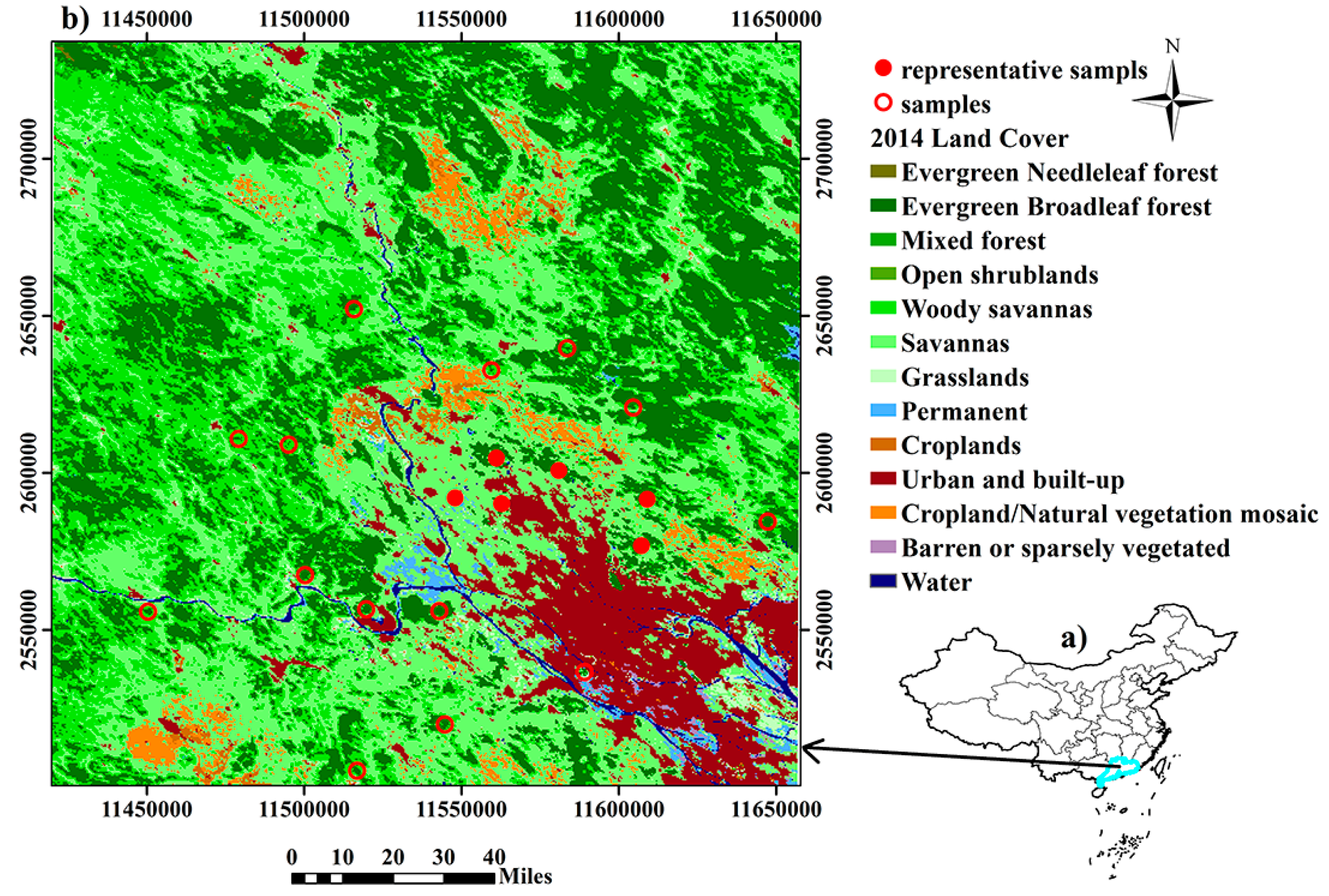
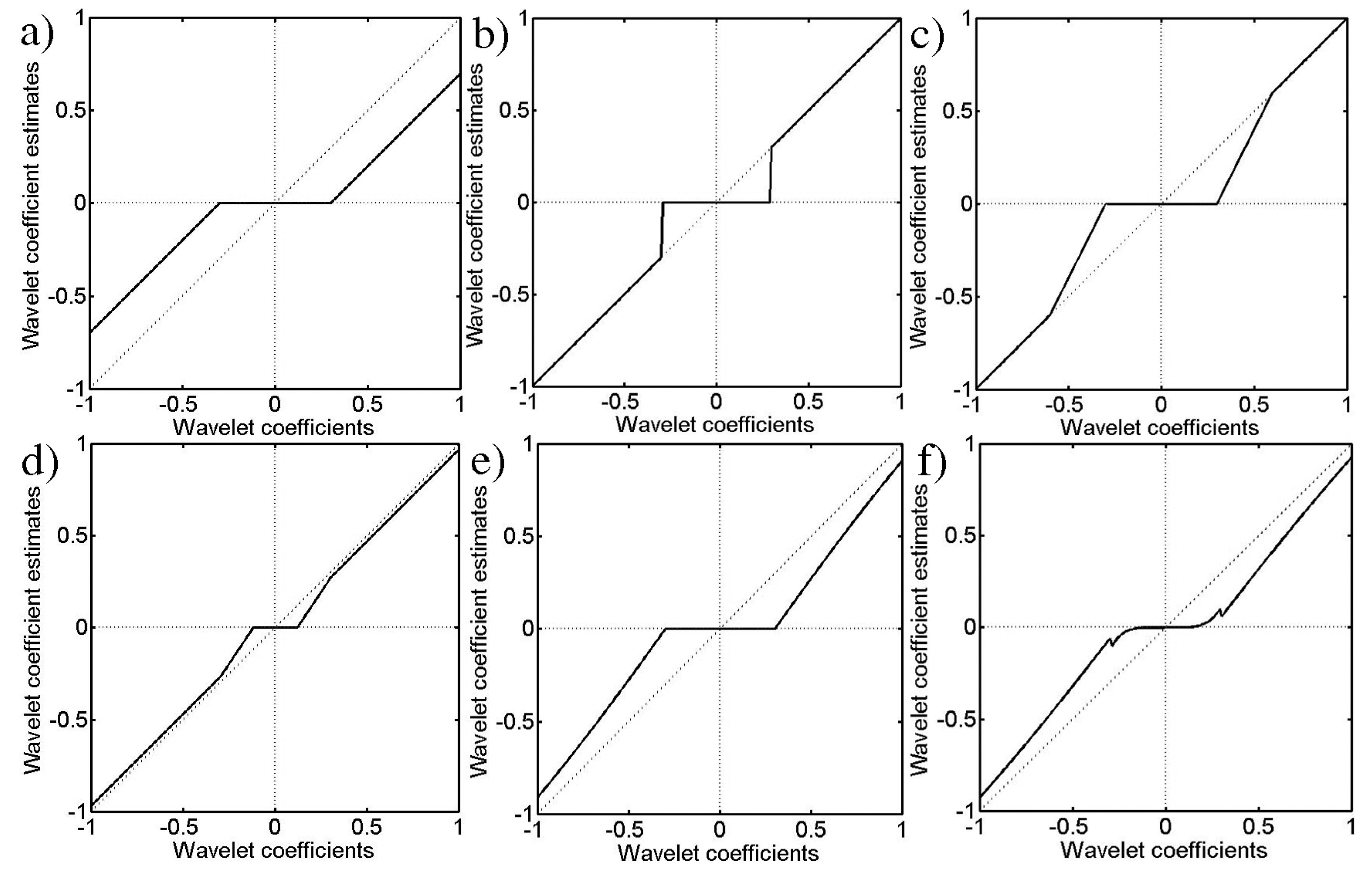

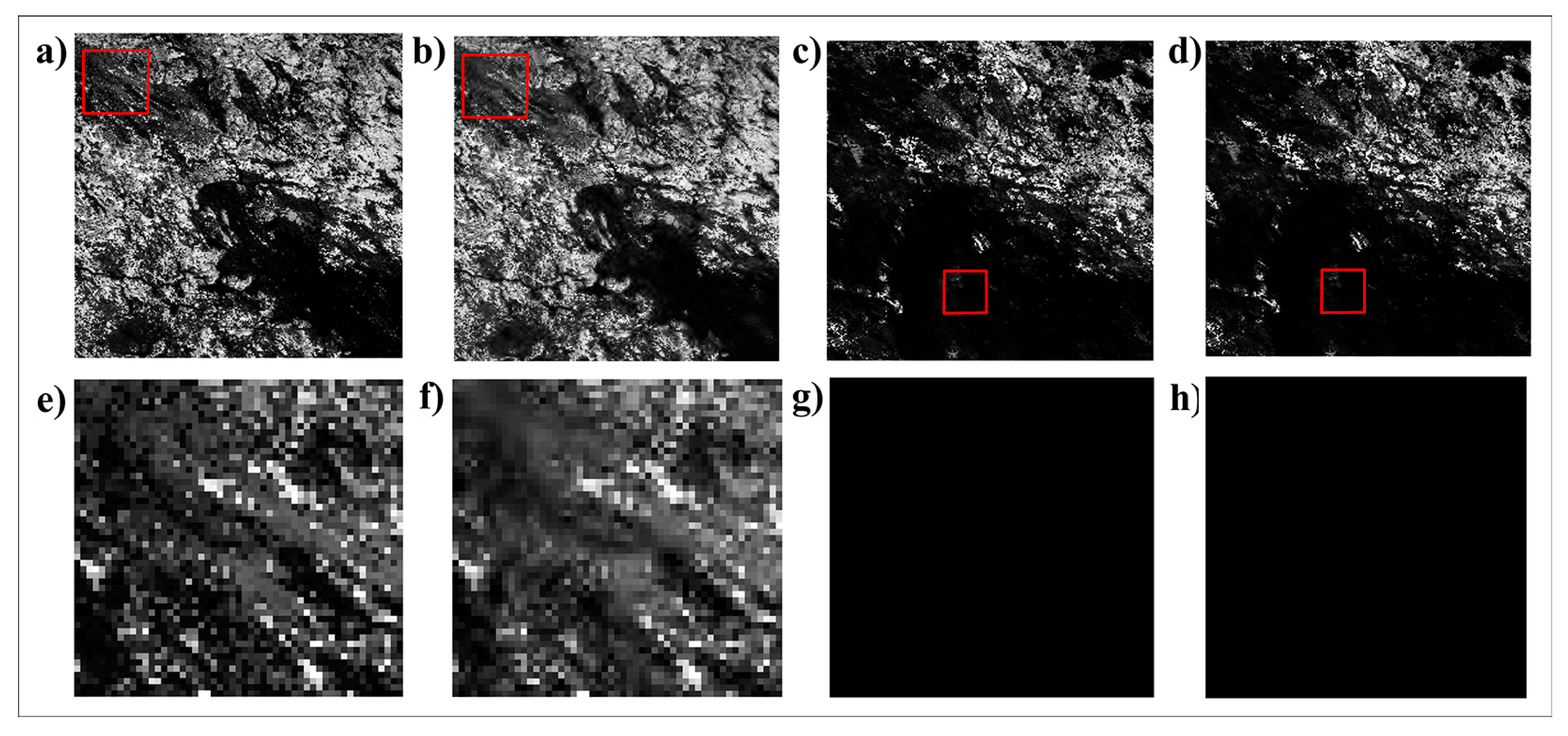
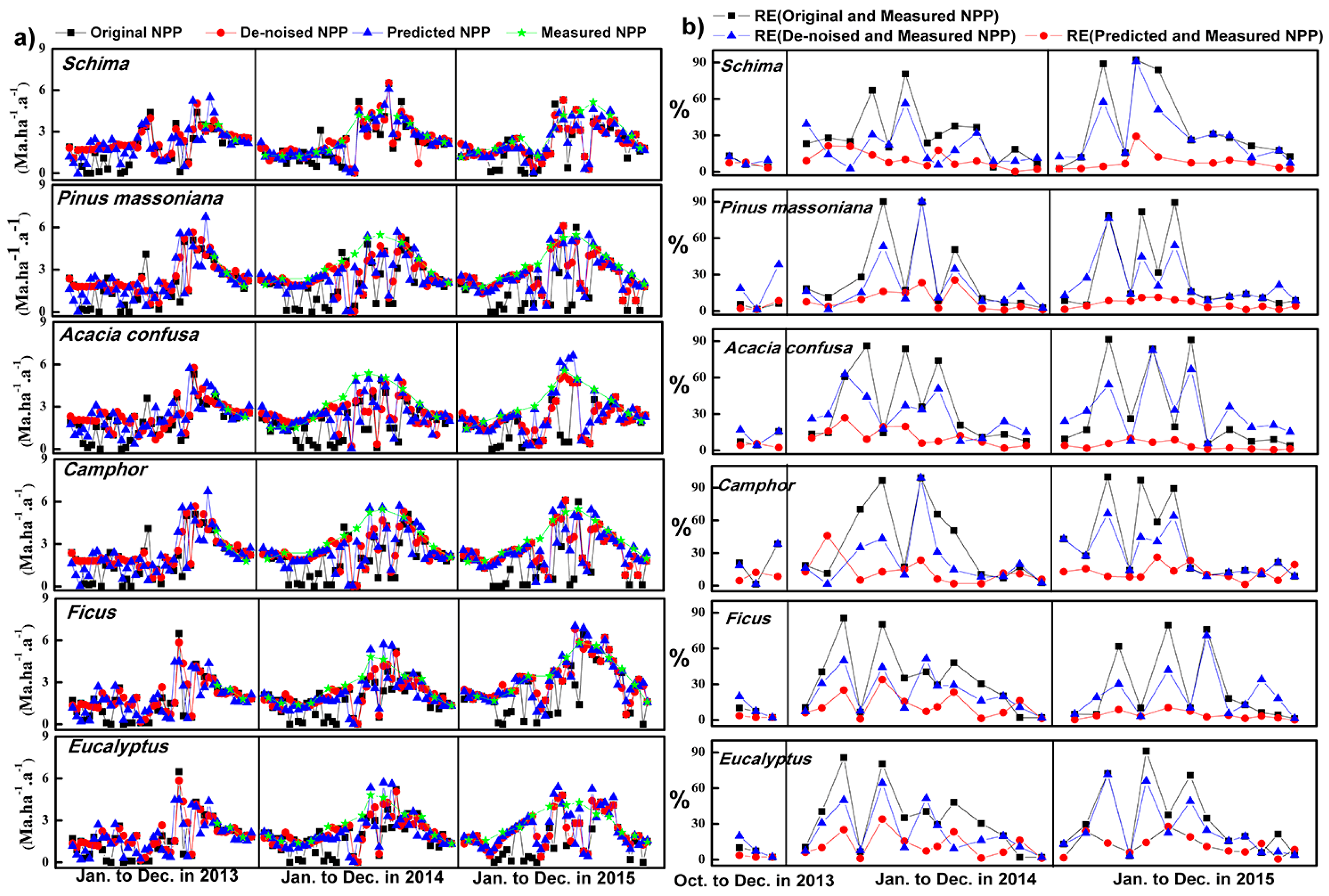
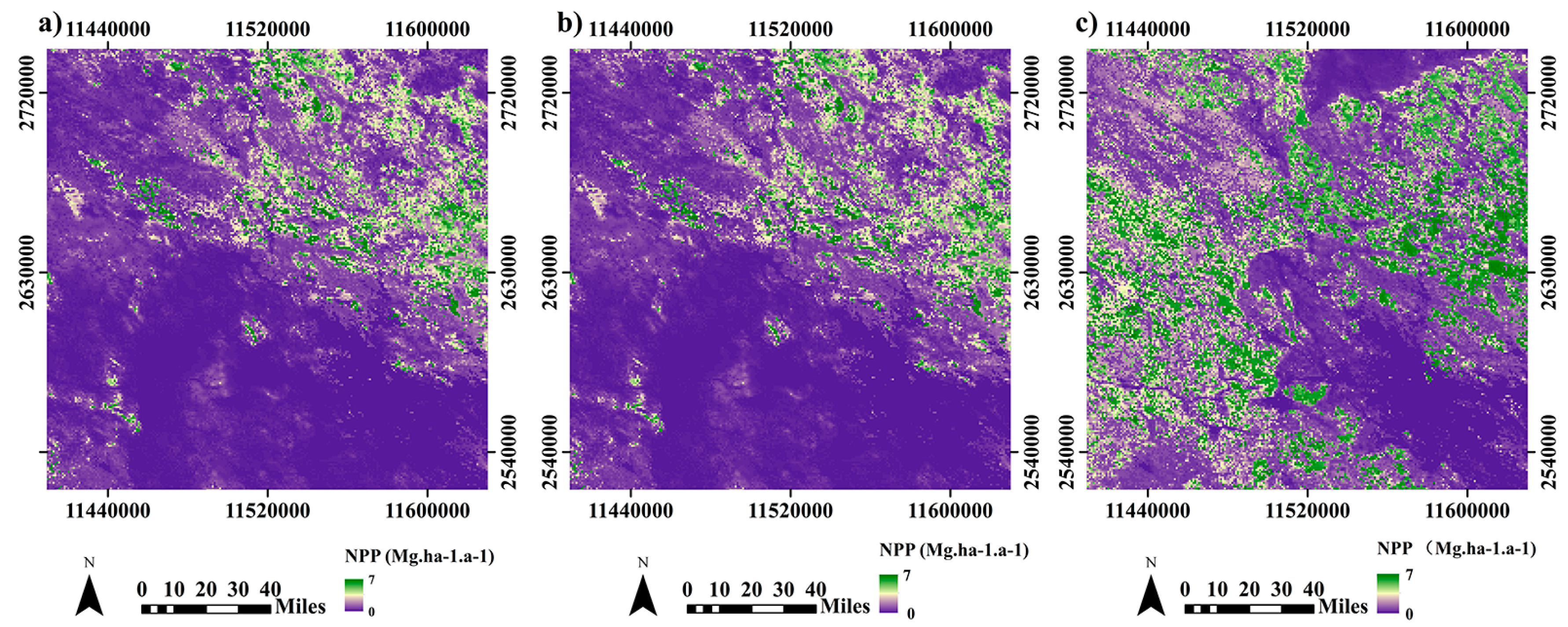
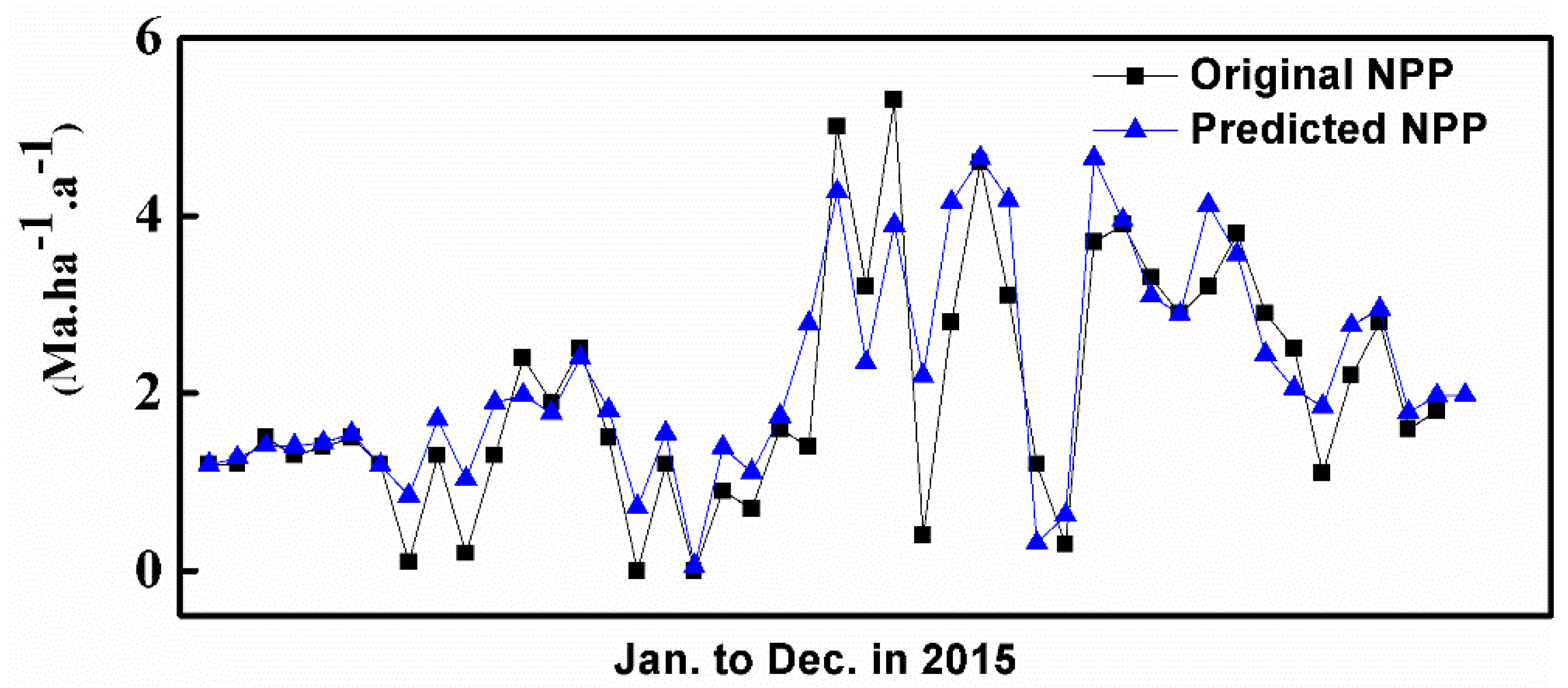
| Threshold function | SNR | RMSD |
|---|---|---|
| ST | 12.11 | 0.69 |
| HT | 9.02 | 0.99 |
| HST | 10.86 | 0.82 |
| ISHST | 9.95 | 0.89 |
| ISHT | 17.20 | 0.38 |
| ISIT | 11.38 | 0.75 |
| Plot# | Species | Measured NPP | Original NPP | RE (%) | De-Noised NPP | RE (%) | Predicted NPP | RE (%) |
|---|---|---|---|---|---|---|---|---|
| 1 | Pinus massoniana | 3.72 | 2.78 | 25.27 | 2.89 | 22.31 | 3.49 | 6.18 |
| 2 | Bamboo | 3.65 | 3.34 | 8.60 | 3.64 | 0.39 | 3.39 | 7.23 |
| 3 | Eucalyptus | 3.92 | 3.10 | 20.92 | 3.24 | 17.35 | 3.33 | 15.05 |
| 4 | Acacia confusa | 3.90 | 2.80 | 28.21 | 3.30 | 15.39 | 3.15 | 19.23 |
| 5 | Ficus | 3.88 | 2.90 | 25.31 | 3.31 | 14.75 | 3.27 | 15.78 |
| 6 | Pinus massoniana | 4.17 | 3.20 | 23.26 | 3.36 | 19.42 | 3.39 | 18.71 |
| 7 | Mucuna Birdwoodiana | 4.62 | 2.90 | 32.90 | 3.2 | 26.41 | 4.26 | 7.79 |
| 8 | Mulberry | 4.58 | 3.40 | 25.69 | 3.40 | 25.69 | 3.66 | 20.01 |
| 9 | Pinus massoniana | 4.64 | 3.37 | 27.37 | 3.45 | 25.65 | 3.34 | 28.02 |
| 10 | Schima | 4.07 | 3.12 | 28.10 | 3.57 | 12.39 | 3.18 | 21.96 |
| 11 | Cheery blossom | 3.70 | 2.92 | 21.13 | 3.68 | 0.60 | 3.40 | 8.16 |
| 12 | Ficus | 4.01 | 3.30 | 17.80 | 3.76 | 6.35 | 3.37 | 16.06 |
| 13 | Camphor | 4.70 | 3.25 | 30.85 | 3.18 | 32.34 | 3.76 | 20.00 |
| 14 | Pinus massoniana | 3.96 | 3.72 | 6.06 | 3.24 | 18.18 | 3.57 | 9.85 |
| 15 | Camphor | 4.04 | 3.30 | 18.29 | 3.30 | 18.29 | 3.35 | 17.05 |
| 16 | Lychee | 4.05 | 3.05 | 24.71 | 3.34 | 17.55 | 3.87 | 4.46 |
| 17 | Camphor | 4.50 | 3.17 | 29.56 | 3.50 | 22.22 | 3.85 | 14.44 |
| 18 | Delonix regia | 4.23 | 3.20 | 24.35 | 3.72 | 12.06 | 4.11 | 2.84 |
| 19 | Tea tree | 4.44 | 3.30 | 25.60 | 3.74 | 15.68 | 3.95 | 10.95 |
| 20 | Alsophila spinulosa | 4.96 | 3.80 | 23.38 | 4.02 | 18.94 | 4.19 | 15.52 |
| Mean | 4.19 | 3.19 | 23.58 | 3.45 | 17.10 | 3.59 | 13.96 | |
| SD | 0.38 | 0.28 | 0.26 | 0.34 | ||||
| rRMSE (%) | 24.98 | 19.50 | 15.67 | |||||
© 2019 by the authors. Licensee MDPI, Basel, Switzerland. This article is an open access article distributed under the terms and conditions of the Creative Commons Attribution (CC BY) license (http://creativecommons.org/licenses/by/4.0/).
Share and Cite
Liu, Z.; Wang, T.; Qu, Y.; Liu, H.; Wu, X.; Wen, Y. Prediction of High-Quality MODIS-NPP Product Data. Remote Sens. 2019, 11, 1458. https://doi.org/10.3390/rs11121458
Liu Z, Wang T, Qu Y, Liu H, Wu X, Wen Y. Prediction of High-Quality MODIS-NPP Product Data. Remote Sensing. 2019; 11(12):1458. https://doi.org/10.3390/rs11121458
Chicago/Turabian StyleLiu, Zhenhua, Ting Wang, Yonghua Qu, Huiming Liu, Xiaofang Wu, and Ya Wen. 2019. "Prediction of High-Quality MODIS-NPP Product Data" Remote Sensing 11, no. 12: 1458. https://doi.org/10.3390/rs11121458
APA StyleLiu, Z., Wang, T., Qu, Y., Liu, H., Wu, X., & Wen, Y. (2019). Prediction of High-Quality MODIS-NPP Product Data. Remote Sensing, 11(12), 1458. https://doi.org/10.3390/rs11121458






